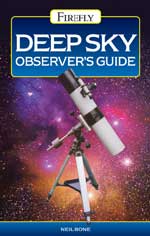
Deep sky observing is the sport of picking out significant, night-time, light sources with the aid of an optical lens. More than just enlarging pinpricks, the lens or lenses evolve the light sources into patterns, shapes and even distinct colours. Of course, with people having stared up at the night sky for ages, with and without aids, some significant knowledge gets built up. There are the shapes that form the signs of the zodiac, precession that defines epochs and historians who record the rise and fall of stellar blazes. As a backdrop to all of these, there are literally billions of other lights sources. This is where the guide’s strength lies as it helps a viewer enter this realm via useful guideposts, notices and advertisements.
In particular, this guide details over 200 night time sparkles. Seven chapters divide these into well known stellar entities, such as galaxies and nebulae. Each individual description includes some basic information; the popular name, where its located (right ascension and declination) and its magnitude. Then, more useful for the amateur viewer, come tricks on seeing the correct sparkle through your binoculars or telescope; the best magnification, viewing style (direct or averted) and any locating stars. Often, bonus comments supply details on the history of its observations, perhaps a bit on the physics involved (e.g. the light is from emissions due to depleted oxygen atoms capturing an electron), and a bit on the stellar activity (e.g. part of a galaxy’s spiral arms ). Having over 400 years of observations to consider makes a guide book like this an extremely practical starting point before venturing into the night time skies.
To further help the amateur astronomer in their activities, Neil Bone fills out his guide with some useful background information. Each chapter begins with a snippet of information about the category. For instance, galaxies, we’re told, are collections that formed in the early stages of the universe and have a uniform field of motion. Where appropriate, morphological classifications further divide categories. Again for galaxies, Edwin Hubble’s “tuning fork” model sets the delineations. And in extending this background further, Bone provides a quick synopsis on the mechanics or evolutions of the subject and expectations for change. Planetary nebulae, for instance, result from a normal star aging into a red star, which subsequently swells further and expels vast amounts of itself in a very vivid explosion, the after effects being the observed nebula. With all this information, the night time sparkles do indeed look more and more take on the value of diamonds.
Aside from expanding on what’s viewed in the lens, Bone’s guide also provides some useful insight on periphery issues. The equipment; binoculars, refractors, mounts and eyepieces get their due. Hints abound throughout, such as the benefits of portable equipment to allow for the necessary commute away from obscuring city lights. The history of viewing identifies some of the important individuals as well as some of their unique instruments. For example, most subjects come with their Messier’s identification. We also learn about de Chesaux’s catalogue of 9776 objects. Bode identified 77 nebulous groups while Hershel had his own list of 400. Reworking through any of these lists could be a lifetime challenge but then there’s the Messier Marathon. Here, a person tries to observe each of the 110 Messier objects in one night. To aid in this or more leisurely pursuits, the guide comes well abridged with field sketches, pictures and diagrams. Wide-field star charts and deep sky listings by constellation, season and magnitude complete the tidbits of information.
Listing stellar objects vitals could very easily have resulted in an extremely dry text. Luckily Bone doesn’t fall completely into this trap. There are many charts and tables, and though each description reads like a recipe, there are also many personal anecdotes and opinions to remind the reader that this book is for the hobbyist who wants to enjoy their pastime. This, together with the provision of club names as well as national and international organizations, give great ideas on how to inflame an amateur viewer’s passion.
Having a handy back pocket reference is essential for star-parties or any late night venues where the stars come into focus. Neil Bone, in his book Deep Sky Observer’s Guide gives this excellent reference for this activity. With descriptions aplenty and star charts spanning all the heavens, this book will enable you to leap to the rescue when someone wonders, “What’s that dot up there?”.
To get your own copy, visit Amazon.com.
Review by Mark Mortimer
